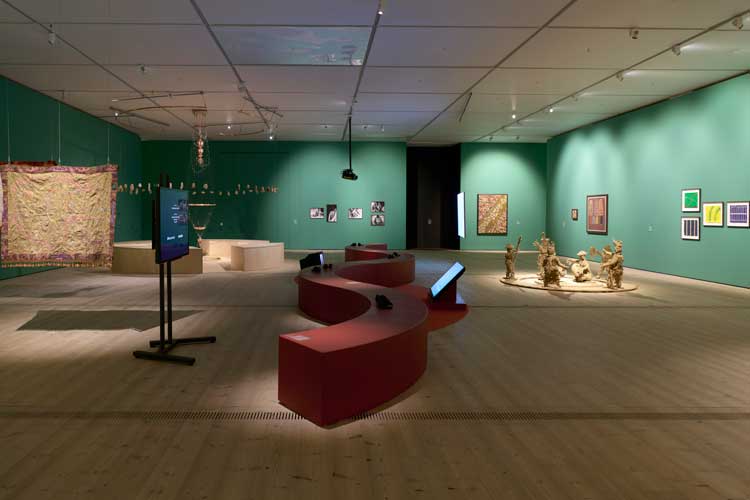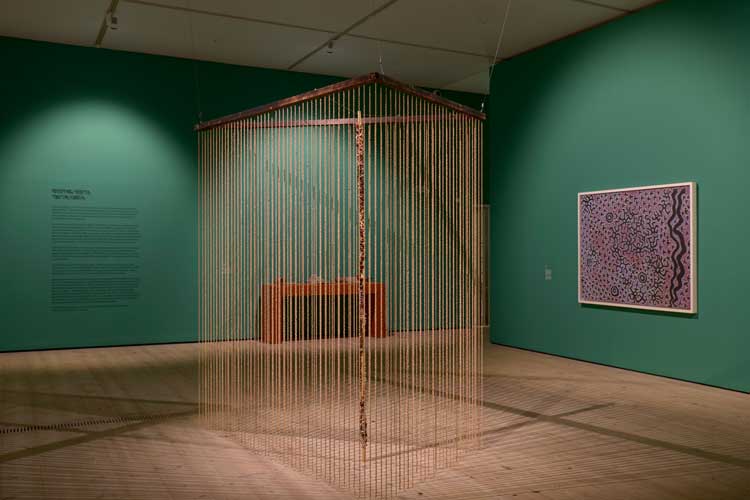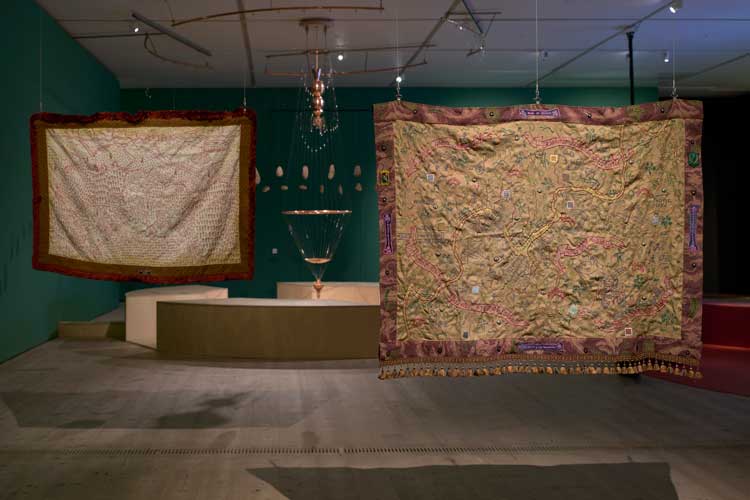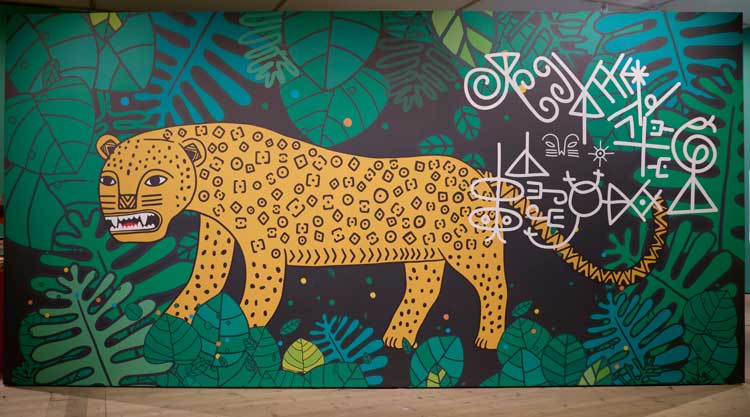
Mural by Denilson Baniwa, exhibition view, Stepping Softly on the Earth, Baltic Centre for Contemporary Art, Gateshead. Photo: John McKenzie. @Baltic Centre for Contemporary Art.
Baltic, Gateshead
18 November 2023 – 14 April 2024
by VERONICA SIMPSON
Entering Baltic’s latest exhibition, you get an overriding impression of fragility, as if you are encountering a delicate ecosystem. Which, of course, you are, mentally, imaginatively and topically. Strings of soybeans hang from threads framing the work of the Brazilian artist Aline Baiana, while elsewhere hand-woven maps, photographs of dried-up salt lakes and their dwindling communities and video works detailing the hard labour required in the apple orchard monoculture of the Atlas Mountains weave around the room, their sound and lighting levels finely calibrated to draw just enough and not too much attention. Every work demonstrates the perilous imbalance of the world around us and how our relationship with these landscapes is poisoning them or us – usually both. But the atmosphere is not one of strife. It is strangely meditative and calm. Deep-green paint on the walls, plus the gentle plip of a water feature at the far end draw us into its unique internal atmosphere.
The title, Stepping Softly on the Earth, draws on a quote by Chief Seattle (c1786-1866), leader of the Suquamish and Duwamish Native American tribes, which is often cited in environmental and ecological theory and activism, although the exhibition’s curators, Irene Aristizábal (who is also Baltic’s head of curatorial and public practice) and Kinnari Saraiya, also reference the Indigenous activist Ailton Krenak’s 2022 book Ancestral Futures. Aristizábal says: “The exhibition is thinking about land and territory from a decolonial perspective, to conceive and understand the world as a pluriverse, where many worlds exist, and they don’t try to cancel each other, they support each other. Also taking the perspective that nature and humans are not separated. Body and mind are not separated. But, really, considering all this through the perspective of land and territory – the land, the person, the nature around it, they’re not separated. There are Indigenous cultures for whom there’s no different word for nature and culture. It’s a unity or a web of interconnectedness.”

Conceived by Brazilian exhibition designer Juliana Godoy as an immersive space for contemplation. Exhibition view, Stepping Softly on the Earth, Baltic Centre for Contemporary Art, Gateshead. Photo: John McKenzie. @Baltic Centre for Contemporary Art.
A web of connectedness, or useful networks, also informed the curatorial programme, emerging through a collaborative research project between Baltic, working with the Institute of International Visual Arts in London and four international partners, CAPC Museum of Contemporary Art Museum in Bordeaux, La Escocesa in Barcelona, Mas Arte Más Acción in Bogotá and Pivô in São Paulo. Each organisation suggested Indigenous groups and artists working to explore environmental impacts.
Pic-V-Simpson.jpg)
Dharmendra Prasad, Memories of a Tree, 2023. Photo: Veronica Simpson.
So how does that complexity translate to the visitor experience? There is a nice amount of tactility, with many objects to interact with throughout the show, starting with the first works, Indian artist Dharmendra Prasad’s books made with soft, handwoven pages, their spines formed from large branches, their edges fraying, pages heavy with soil, mud and seeds. Called Harvest Dreams (2023), Memories of a Tree (2023) and Soil Book (2023), these are a byproduct of the Harvest School project run by the artist in the villages in Assam and Bihar. They feature the stories, histories and observations of the farmers, craftsmen, fishermen, families and young participants. Harvest Dreams depicts beautifully sketched interactions between farmers and elephants in the Rani Forest reserve. Memories of a Tree bears witness to the patterns and texture of the roots and bark of a sal tree from Checha Village. Soil Book features fragments of scattered earth, but appears largely unmarked: it is still, apparently, awaiting the rest of its story.

Aline Bayana, Earthseed or Archipelago #1, 2022. Exhibition view, Stepping Softly on the Earth, Baltic Centre for Contemporary Art, Gateshead. Photo: John McKenzie. @Baltic Centre for Contemporary Art.
Baiana’s Earthseed or Archipelago #1 (2022), with its bead curtain of strung soybeans, is an articulation of the destructive power of monocultural planting. Giant soya farms now dominate the landscape of Brazil, destroying the diversity and resilience of the soil as well as the wider ecology. As in real life, these soy curtains obscure the vitality of the indigenous beans and seeds with which Baiana has adorned a totem-style pole at the structure’s core.
-Pic-V-Simpson.jpg)
Roy Underwood, Ilkurlka, 2005. Photo: Veronica Simpson.
Australian Indigenous artist Roy Underwood’s spot painting Ilkurlka (2005) pulsates with life forms, literal and figurative, visceral and spiritual, geographic and biological, the shapes reminiscent of birds, blood cells and madly waving synapses. This painting is honouring a rock hole at Miramiratjara, a sacred water source in the Australian desert. The two snakes on the right-hand side represent ancestral human protagonists of the Wati Kutjara creation story, while the three-pronged forms scattered across the painting represent emu tracks.
Following these are Iranian Solmaz Daryani’s photographs entitled The Eyes of Earth (The Death of Lake Urmia) (2014-ongoing). Since 2014, Daryani, an acclaimed Iranian photographer and activist, has been charting the gradual shrinkage of Lake Urmia, which used to be the sixth largest saltwater lake in the world. The lake was once a thriving tourist hub and her grandfather ran a hotel here while her uncles took visitors sailing across the lake. She offers a range of images, micro and macro, to immerse us in this environmental drama, witnesses to the destruction of the lake, which has lost almost 90% of its volume since 1972.

Cian Dayrit's embroideries frame Leonel Vásquez' water sculpture. Photo: Veronica Simpson.
Floating in the room nearby are two of the Filipino artist Cian Dayrit’s tactile embroideries: these featured in the Talbot Rice Gallery’s exhibition The Accursed Share, earlier this year. Like most of his textiles, they map the colonising influences of extractive capitalism in his Philippines homeland. With “a counter cartographic practice embedded in community collaboration”, these works articulate the feelings of communities impacted by the controversial Kaliwa Dam project. While the first, Entanglements with Entitled Extractive Establishments (Eee!) (2023), is embroidered in a more conventional mapped style, the second, To Block the Flow of a River Is to Reject the Wisdom of the Earth (2023) features personal stories, captions and emblems, names and slogans and beads that look like eyes; though indecipherable to most of us, the embroidery communicates a sense of urgency and vigilance.

Leonel Vásquez, water temple, exhibition view, Stepping Softly on the Earth, Baltic Centre for Contemporary Art, Gateshead. Photo: John McKenzie. @Baltic Centre for Contemporary Art.
Anchoring us in the far corner, with a steady, amplified drip, is the work of the Colombian artist Leonel Vásquez, one of two pieces commissioned for this show. In his sculptural sound installations, Vásquez likes to create instruments as well as environments. Here, he has made a porous temple around the instrument, which is slightly raised off the floor and framed by a broken circle of wide, pale wooden benching. Piano strings surround the central sculptural element, a kind of brass chandelier descending through a ring towards a beaten brass disc on to which drips water (recycled from the basin below, which then catches the drips). Secured within a surrounding circle of strings are rocks sourced from a spot where the south Tyne and the north Tyne meet (and to which they will be returned after the exhibition). Aristizábal advises me to lie on one of the benches and close my eyes: “You can feel the sound in your body,” she says. Vásquez, she continues, “is really interested in the healing properties of water but also of thinking and understanding water as a being that is alive and its connection to us as humans – given that we are 80% water.” This work also invites us to think about the longstanding role of water in rituals, from which our modern lives are now almost entirely divorced. During an hour or more spent in the exhibition, I see many people sitting quietly for five to 10 minutes contemplating this delicate, gleaming installation.
Curving through the centre of the room is a snaking, red bench, which Aristizábal says represents a river, but also invities us to sit and engage with three of the adjacent video works. On a smallish TV, we watch Nguné Elü (The Day the Moon Menstruated, 2004), a documentary recorded by and for the Kuikuro people to capture their rituals during a solar eclipse – from mildly gruelling scenes of tribespeople using fine wooden combs to scrape their skin until it bleeds, so they can paint their bodies in the red blood, to endearing scenes of men gazing into a handheld a mirror to apply charcoal face markings (reminding me of teenagers preparing for a night’s clubbing) and uplifting tales of women’s self-chosen rituals of seclusion and rest while menstruating. Artists Takumã and Maricá Kuikuro produced this video during workshops with Vídeo Nas Aldeias in the Kuikuro village in the Upper Xingu, Brazil.
-Seasonal-Work-Song-(2023).jpg)
Film by Moroccan collective Tizintizwa (comprising Nadir Bouhmouch and Soumeya Ait Ahmed), A (Rough) Seasonal Work Song, 2023, exhibition view, Stepping Softly on the Earth, Baltic Centre for Contemporary Art, Gateshead. Photo: John McKenzie. @Baltic Centre for Contemporary Art.
On a larger screen facing the far wall is a film by the Moroccan collective Tizintizwa (comprising Nadir Bouhmouch and Soumeya Ait Ahmed). A (Rough) Seasonal Work Song (2023) is a portrait of the Atlas Mountains as they endure a monocultural evolution, the slopes increasingly dominated by apple trees, most of the produce from which is shipped to Europe. While the film tracks these orchards and their workers through the seasons, via headphones we hear ancient songs and poetry woven into the stories of toil and hardship.

Ursula Biemann’s film Vocal Cognitive Territory, 2022. Photo: Veronica Simpson.
Nearby, at the far end of the gallery is a room showing a two-screen video installation, Vocal Cognitive Territory (2022), also shown at this year’s Venice Architecture Biennale. It is part of Swiss-based artist Ursula Biemann’s long-term project Devenir Universidad. Biemann has been working with the Inga people of south-west Colombia since 2018, and her films are designed to articulate their indigenous knowledge and share it as an indigenous university. With dignity and simplicity, various elders and teachers outline the ways in which they are trying to repair or resist the damage visited on their territory by extractive capitalism and their efforts to maintain their ancestral practices.

Shatabdi Chakrabarti, Traditions on Skin depicting Baiga women of Madhya Pradesh, exhibition view, Stepping Softly on the Earth, Baltic Centre for Contemporary Art, Gateshead. Photo: John McKenzie. @Baltic Centre for Contemporary Art.
On the left-hand side of the screening room door are some arresting black-and-white photographs taken by Shatabdi Chakrabarti, Traditions on Skin: Tattoo Making Among Baiga Women (2021). The Baiga women of Madhya Pradesh in India believe that, through tattooing their bodies (with an ink made from charcoal and water) with ancient geometric symbols, they continue a tradition that stretches back to Earth’s original inhabitants. From the women’s radiant faces and relaxed postures, these portraits, along with the geometric intricacies of their inked bodies, present a very different view of tattoos: as an act of integration with community and ancestry rather than the impetus with which we are more familiar – of rebellion, self-identity and difference.

Portrait from Shatabdi Chakrabarti's Baiga Tattoo series. Photo: Veronica Simpson.
On the opposite flank of the doorway is another Aboriginal spot painting, this one by Clifford Possum Tjapaltjarri (Kangaroo Dreaming 1986). He is of the founding fathers of the “dot-and-circle” desert painting movement that emerged in the Northern Territory of Australia in the 1970s, but this work is unusual in that it offers a schematised representation of the land – an aerial view – as well as a record of the myths detailing how that land came into being.
Two further works to the right are by Queenie McKenzie Nakara, one of the most prominent female painters of the Kimberley region in Western Australia. She is also known for introducing new perspectives that blend the symbols and spirituality of the Aboriginal traditions with more contemporary perspectives. While one painting, Argyle Diamond (1997), seems to give us a closeup of diamond shapes in an almost quilt-like arrangement (protesting the industrialised mining of diamonds through the deep, dried blood and flesh pigments she uses, perhaps), the other gives us an unusual, horizontal head-on perspective of what look like large boulders (Koora Koora Dreamtime, undated).

Foreground: Seven figures made by the Gidree Bawlee Foundation and artist Kamruzzaman Shadhin; Background: Shereoanawe Hakihiiwe's indigenous plant and element paintings. Exhibition view, Stepping Softly on the Earth, Baltic Centre for Contemporary Art, Gateshead. Photo: John McKenzie. @Baltic Centre for Contemporary Art.
Gidree Bawlee Foundation of Arts was founded by the artist Kamruzzaman Shadhin in 2001, in the north-west region of Bangladesh. Together, they present Kaal (Time) (2023), described as “a constellation of seven figures” who represent key characters in a traditional rural folk-theatre pageant called Bishahari Pala. These charming figures were handwoven out of jute, on aluminium structures. Forming a glowing backdrop to this performance, on the adjacent wall is a collection of gorgeously coloured elemental works by the Amazonian/Venezuelan artist Sheroanawe Hakihiiwe. Using paper handmade from indigenous plants, Hakihiiwe represents the plants and elements that provide literal and spiritual nourishment for the Yanomami people. This selection is unusual for the deep, rich tones selected as a background for the simplified, essential figures with which Hakihiiwe communicates the object and its spirit counterpart, whether vines, palm trees, rivers or roads.
Two further film works are spaced around the room: the Karrabing Collective’s Night Fishing with Ancestors (2023) (also showing at Goldsmiths London until 14 January) relates the story of Indonesia’s Maccasan traders’ first encounters with Indigenous Australians, composed with the collective’s customary candour about colonisation and revealing erased histories. We also have a recent work by Marwa Arsanios, Who Is Afraid of Ideology? (2017-), first seen at Documenta 15 (2022). The Lebanese artist explores how the evocation of ancient laws in her home country could bring a privately owned quarry back into collective ownership, moving the human relationship with the land away from the commercial and exploitative.
One last video work is separated off from the room by an enclosure: Naomi Rincón Gallardo’s Eclipse (2023), a piece co-commissioned between Baltic and Artes Mundi, for whom the Mexican artist is one of this year’s shortlisted artists. With her signature mix of playfulness, humour, homemade costumes and dark subjects, she plays out the last chapter of her Tzitzimime Trilogy (2021-23) in which the worlds of the living and the dead merge.

Mural by Denilson Baniwa, exhibition view, Stepping Softly on the Earth, Baltic Centre for Contemporary Art, Gateshead. Photo: John McKenzie. @Baltic Centre for Contemporary Art.
On the exterior of this enclosure is a larger than life, golden jaguar in a dense, green forest, painted by Denilson Baniwa, from Rio de Janeiro, whose practice foregrounds indigenous representations of culture and knowledge in the Americas. Replicating a mural he made in Rio, he is representing the jaguar for its shamanic power: jaguars are seen as animals that assist in transitioning from one world to another, says Aristizábal. Its location at the entrance and the exit of the exhibition is surely significant.
Everything in this room has been placed with great care and attention to atmosphere and content, Aristizábal tells me: “We worked with the Brazilian exhibition designer Juliana Godoy … to bring another pair of eyes, to think about how we can make the experience for visitors into an embodied experience. Very often when people come to an exhibition, they think it’s an intellectual experience only. It’s inviting people to say that knowledge and learning does happen through the body as well. We have different levels of seating and the lighting is different here and there. There are moments of looking up and looking down. At the back (with the water sculpture), there is a full-on body experience.” And she’s right. The quality of quiet and concentration conjured in the room through the subtle shifts in staging does enable a more focused kind of looking. We may pay closer attention to these artworks, most of which have evolved over long periods and through deep connections with the communities in question – not to mention the thousands of years over which their philosophies have evolved. A fascinating marriage of form and function, the experience stays in the mind – and maybe the heart – for longer, as a result.